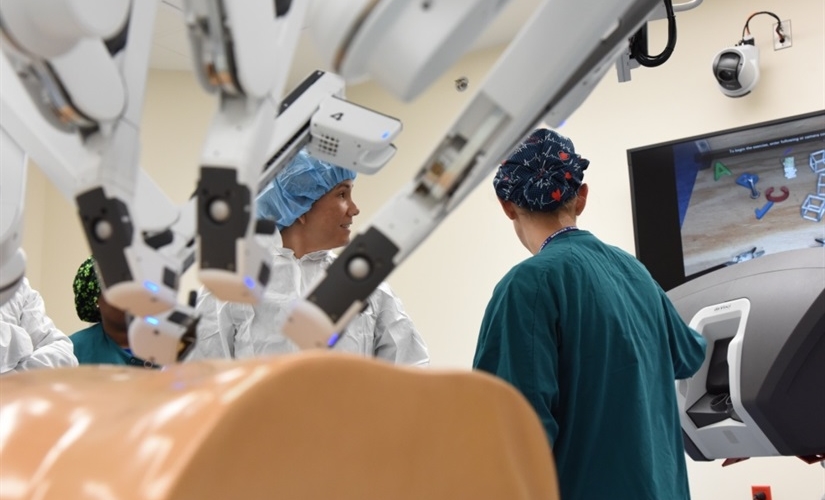Weighing the Advantages and Disadvantages of Robotic Surgery

Surgery is something that, until the 2000s, was considered the purview of medical specialists. If you went to the hospital for a surgical procedure, you could expect to be attended by a human surgeon — until robots entered the operating room. Since then, several companies, such as Intuitive Surgical, Mazor X and even some universities respond to the demand of hospitals which commit, slowly but surely, to the integration of robotic operating systems. Thus, what is robotic surgery?
What Is Robotic Surgery?
Robotic surgery, as its name suggests, is surgery that is carried out by a robot. It's a minimally invasive surgery, which means it's capable of performing complicated surgical techniques through tiny incisions, leaving very little scar tissue behind. The robot is the tool here, just like a scalpel or a set of forceps would be a tool for a skilled surgeon. The surgeon will sit at the robot's controls, guiding the surgical instruments at the end of the robot's arms with high definition 3-D cameras.
Surgeons who perform procedures with these remote-controlled robots have compared it to miniaturizing their bodies and traveling inside their patient, giving them a closer look at the job they're doing without having to open the patient up. It sounds like an ideal situation, but it isn't all sunshine and roses. In order to give you a better perspective, here are the benefits and the downsides of robotic surgery:
Advantage #1: Smaller Incisions and Less Trauma
The nature of robotic surgery is less invasive, which means the patient experiences less pain and quicker recovery time. The surgical arms are often pneumatic, powered by compressed air and electricity to control the operation. The ‘hands’ of each arm, which hold each of the necessary surgical tools, are also smaller than human hands, which eliminates the need for large incisions. The surgeon remains in the operating room throughout the procedure. A team of nurses also monitors the patient during the process.

Surgeries that normally result in a week-long post-operative hospital stay can potentially become outpatient procedures. A liver resection, for example, would keep a patient hospital-bound for a week or more after a traditional procedure. Using a robot reduces that hospital stay to just one or two days.
Disadvantage #1: The Expense of Surgery
Surgery is an expensive proposition at the best of times. The high cost of installing a robotic surgery system can increase the cost of a surgical procedure. Surgical robots are costly to maintain, and their operation requires additional training, which is also expensive. Exact numbers are difficult to come by, but in general, a surgery utilizing a da Vinci surgery robot will cost between $3,000 and $6,000 more than a traditional laparoscopic procedure.
Advantage #2: Higher Surgical Accuracy
Some surgeries — from orthopedic operations to neurological procedures — require a high degree of accuracy. One slip of the scalpel or misplaced set of forceps can cause damage or even result in the death of the patient. Robotic surgery robots aren't susceptible to the shaking or other strain-related movements a human surgeon might experience. If the controller’s hands are shaking, the machine’s software compensates for that movement, so it doesn’t affect the surgery.

Each robotic hand can rotate 360 degrees multiple times, something that human hands can’t do. This increases their range of motion. It is equipped with small joints that allow each arm to bend like a human wrist. This is an improvement over traditional laparoscopic tools, which are straight and unable to bend so they are harder to manipulate. It is also equipped with a 3D high definition camera, providing a better view of the surgical site than would be available otherwise, even during open surgery.
Disadvantage #2: Movement Latency
One of the most significant problems with robotic surgery is the issue of latency — the time it takes for the robot to carry out the surgeon's commands. It takes a few moments for the computer to communicate with the robotic arms. While this isn't an issue for routine surgeries, it makes it difficult for surgeons to respond quickly to problems that occur during the operation.
Advantage #3: Reduced Surgeon Fatigue
Surgeries, especially ones that take multiple hours, are exhausting for the attending surgeon. The team is on their feet for hours at a time, completing the surgery and attending to the patient. Surgery robots allow the surgeon to sit comfortably while operating.

This could help keep surgeons fresh and aware for the duration of their surgeries, preventing fatigue-related errors and reducing the potential for medical malpractice.
Robotic Surgery in the Coming Years
With the right expertise and technology, the advantages can eventually overcome the disadvantages. Communication latency is currently the biggest hurdle to overcome to allow this technology to hold a more prominent place in the medical community. Even if the cost of the procedure slows down the integration in hospitals, surgeries with robotic machines will continue to become more commonplace, allowing more precise microsurgeries with improved accuracy.
Thanks for helping to keep our community civil!
This post is an advertisement, or vandalism. It is not useful or relevant to the current topic.
You flagged this as spam. Undo flag.Flag Post


